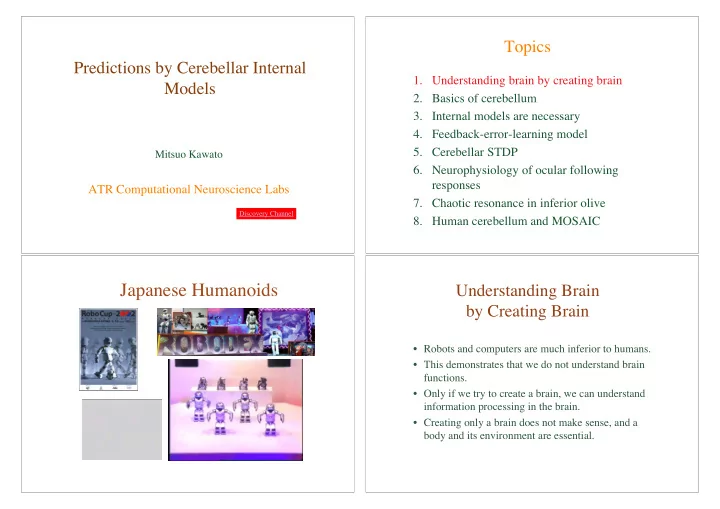

Topics Predictions by Cerebellar Internal 1. Understanding brain by creating brain Models 2. Basics of cerebellum 3. Internal models are necessary 4. Feedback-error-learning model 5. Cerebellar STDP Mitsuo Kawato 6. Neurophysiology of ocular following responses ATR Computational Neuroscience Labs 7. Chaotic resonance in inferior olive Discovery Channel 8. Human cerebellum and MOSAIC Japanese Humanoids Understanding Brain by Creating Brain • Robots and computers are much inferior to humans. • This demonstrates that we do not understand brain functions. • Only if we try to create a brain, we can understand information processing in the brain. • Creating only a brain does not make sense, and a body and its environment are essential.
Computational Neuroscience Endo G, Nakanishi J, Morimoto J, Cheng G: Experimental studies of a neural oscillator for biped locomotion with QRIO. IEEE International Conference on Robotics and Automation , 598-604 (2005) We elucidate information processing of We elucidate information processing of We elucidate information processing of We elucidate information processing of the brain to the extent that artificial the brain to the extent that artificial the brain to the extent that artificial the brain to the extent that artificial machines, either computer programs or machines, either computer programs or machines, either computer programs or machines, either computer programs or robots, can be built to solve the same robots, can be built to solve the same robots, can be built to solve the same robots, can be built to solve the same computational problems that are solved computational problems that are solved computational problems that are solved computational problems that are solved by the brain, essentially in the same by the brain, essentially in the same by the brain, essentially in the same by the brain, essentially in the same principle. principle. principle. principle. Biped Neuroscience Artificial Intelligence, Robotics Schaal S, Sternad D, Osu R, Kawato M: Rhythmic arm movement is not discrete. Nature Neuroscience, 7 , 1137-1144 (2004). By SONY IDL and ATR Collaborative Research Nakanishi J, Morimoto J, Endo G, Cheng G, Schaal S, Kawato M: Learning from demonstration and adaptation of biped locomotion, J. Robotics and Autonomous Systems , 47 , 79-91 (2004). New Humanoid “CB” Humanoid “DB” (Dynamic Brain) with SARCOS • 30 DOFs • 190 cm height An ATR/SARCOS development • 80 kg weight • Compliant • Biomimetic !"#$%&'()$(*+,-.(/%0&&1 oculomotor system -.1(0$2&'3 • Co-designed by SRC !"#$%! "&#'$(! !4+##5(-+)$.$,$+% and KDB !6789,(-.1(78(:; Shibata, T. and Vijayakumar, S. and Conradt, J. and Schaal, S.: Biomimetic Oculomotor Control. Adaptive Behavior , 9 , 189-208 (2001). !<&9*-.=9-##5(9$,0#=-.)
Understanding Hierarchical Topics Sensory-Motor Control by the Brain through Robot Control with Neural Decoding Human ROBOT 1. Understanding brain by creating brain Decision Prefrontal decoding 2. Basics of cerebellum Intention Parietal decoding Internal model CBL decoding 3. Internal models are necessary Muscle activity M1 decoding 4. Feedback-error-learning model 5. Cerebellar STDP 6. Neurophysiology of ocular following responses 7. Chaotic resonance in inferior olive 8. Human cerebellum and MOSAIC SARCOS, ATR, CMU, NiCT Cerebellum and Cerebral Cortex $,-,9,..:4'*;6'<:4*;'=;+,..0>,;?, )*+,-*.'/0,1 5,60*.'/0,1 C'$,-,9,..*-'(:?.,0 '5,60*.'DEFG'A,;+*+,'HEI'-,.*+0J,'+3'K-3B040*; $,-,9,..*-'$3-+,@ '236W77''''''A,;+*+,'(:?.,:B Z,0>]+'''/3.:4,''''''''Z'^'<''''''''),;>E A,;+*+, <:4*; ''_I`>7OGO_Q44 a 7'B*4,7''''+10?, A3-B34,60*. ''HI`>7'''HI_44 a 7'B*4,77'']*.\ $]04K A,;+*+, /,;+-3.*+,-*. 23++34'/0,1 Cerebellum 7 Cerebral Cortex C'$,-,9,..*-'!0L,'*;6' 7777 130g 77 1to10 77 1,300g '''''<:4*;'=;+,..0>,;?, Weight Surface Area 7 50,000mm 2 7 1to2 7 80,000mm 2 ''''''''M*-*60B3'NOPPQR Number of Neurons 7 7 10 11 > 10 11 S0;>,-'+*KK0;> -TDEUU'' KVDEDI Expansion from /,-9*.'4,43-W7 -TDEUQ' KVDEDU Average Primates 2.8 778' 3.2 X,;,-*.'=Y77 -TDEOP' KVDEDQ NZ"=![#R (3'?3--,.*+03;'\3-'.,\+'+,4K3-*.'.39,
$,-,9-3[ Private Communication between $9.4'?3-+,@ $,-,9,..*- $9.4'( Cerebrum and Cerebellum with M( $344:;0?*+03; &]*.*4:B )33K $,-,9-*.'?3-+,@ Closed-loop Circuits $,-,9,..*-'A,,K'(:?.,0 M3;+0;,'(:?.,:B 63-B "-,*'H_ "-,*'P' .*+,-*. 4,6 =;+,-4,60*+, A,;+*+, A,;+*+,'63-B*. A,;+*+,'.*+,-*. A,;+*+,'J,;+-*. &]*.*4:B'/M)3 f 5Ag/) M-04*-W'53+3- /,;+-*.'M-,43+3- M-,\-3;+*. $,-,9-*.'$3-+,@ '$,-,9-*.'$3-+,@ (,:-*.'$0-?:0+G'!W;*K+0?'M.*B+0?0+W'*;6' Neural Circuit of Cerebellar Cortex 536,.B'3\'$,-,9,..:4 '5*--[".9:B[=+3'NbOPQDR Parallel fiber(PF) !+,..*+,'?,..B c$.0490;>'\09,-'0;K:+B'*B'+,*?],- M*-*..,.'\09,- ''''N,--3-'B0>;*.R cM*-*..,.[\09,-[M:-`0;d,[?,..'BW;*KB, 2*B`,+'?,.. ''''?]*;>,B'0+B',\\0?*?W M:-`0;d, ?,.. 53BBW'\09,-B M*-*..,.'\09,-B X3.>0 M:-`0;d,'?,.. ?,.. Granule cell M:-`0;d, ?,.. $.0490;>'\09,-B X.34,-:.:B X-*;:.,'?,..B X-*;:.,'?,.. =;\,-03-'3.0J,' $.0490;> ;,:-3;B Purkinje cell \09,- )3;>'&,-4'A,K-,BB03;G')&MG'#M'NbOPFUR M:-`0;d, $,..'*@3; 53BBW'\09,- =;+,-;*.'536,.'&],3-W'NbOPFHR c$,-,9,..*-'?3-+,@'*?e:0-,B'0;+,-;*.'436,.B Climbing fiber(CF) ''''9W'.,*-;0;> c$.0490;>'\09,-'-,K-,B,;+B'43+3-'?344*;6' '''',--3-
Topics Parallel Fiber and Climbing Fiber Inputs to Purkinje cells: 1. Understanding brain by creating brain Simple Spikes and Complex Spikes 2. Basics of cerebellum Simple spike (SS) Parallel fiber (PF) 3. Internal models are necessary Internal model output A B 4. Feedback-error-learning model 5. Cerebellar STDP Input Complex spike (CS) Complex spike (CS) signal Climbing 6. Neurophysiology of ocular following Error signal Error signal Purkinje cell fiber (CF) responses 7. Chaotic resonance in inferior olive Output signal Error signal 8. Human cerebellum and MOSAIC "''S,,69*?`'?3;+-3. Cerebellar Internal Model Theory !+0\\;,BBG'/0B?3B0+W S,,69*?` A,B0-,6 #,*.0L,6 • The cerebellum consists of many modules 43+3- +-*d,?+3-W +-*d,?+3-W ?344*;6 $3;+-3..,6 X*0; (micro-zones) which perform different input- 39d,?+ output transformations. • Synaptic weights change and different A,.*W transformations can be learned. • Supervised learning guided by an error signal 2''S,,6\3-1*-6'?3;+-3. • Different modules acquire internal models of S,,6\3-1*-6 controlled objects, tools, other brains, etc. #,*.0L,6 43+3- A,B0-,6 +-*d,?+3-W ?344*;6 +-*d,?+3-W $3;+-3..,6 =;J,-B, 39d,?+ 436,. Pole and CBLM
Neuroscience: Tilting Against a Major Theory of Movement Control Stiffness Measurement by PFM "''=;+,-;*.'\,,69*?`'?3;+-3.'9W'\3-1*-6'436,. Hiroaki Gomi 53+3-' #,*.0L,6 A,B0-,6 h ?344*;6 +-*d,?+3-W +-*d,?+3-W S,,69*?` $3;+-3..,6' ?3;+-3..,- 39d,?+ [ S3-1*-6' iB+04*+,6' +-*d,?+3-W 436,. $:--,;+'B+*+, 2''S,,6\3-1*-6'?3;+-3.'9W'0;J,-B,'436,. 53+3-' #,*.0L,6 A,B0-,6 ?344*;6 +-*d,?+3-W +-*d,?+3-W $3;+-3..,6' =;J,-B,' 39d,?+ 436,. Mechanical perturbations in 8 directions were given during point-to-point movement and reaction forces were measured. Then stiffness and viscosity were estimated.
Recommend
More recommend